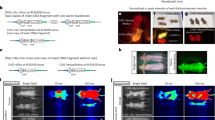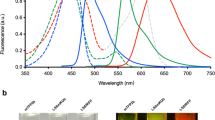Abstract
Imaging of gene-expression patterns in live animals is difficult to achieve with fluorescent proteins because tissues are opaque to visible light. Imaging of transgene expression with magnetic resonance imaging (MRI), which penetrates to deep tissues, has been limited by single reporter visualization capabilities. Moreover, the low-throughput capacity of MRI limits large-scale mutagenesis strategies to improve existing reporters. Here we develop an MRI system, called GeneREFORM, comprising orthogonal reporters for two-color imaging of transgene expression in deep tissues. Starting from two promiscuous deoxyribonucleoside kinases, we computationally designed highly active, orthogonal enzymes (‘reporter genes’) that specifically phosphorylate two MRI-detectable synthetic deoxyribonucleosides (‘reporter probes’). Systemically administered reporter probes exclusively accumulate in cells expressing the designed reporter genes, and their distribution is displayed as pseudo-colored MRI maps based on dynamic proton exchange for noninvasive visualization of transgene expression. We envision that future extensions of GeneREFORM will pave the way to multiplexed deep-tissue mapping of gene expression in live animals.
This is a preview of subscription content, access via your institution
Access options
Access Nature and 54 other Nature Portfolio journals
Get Nature+, our best-value online-access subscription
$29.99 / 30 days
cancel any time
Subscribe to this journal
Receive 12 print issues and online access
$209.00 per year
only $17.42 per issue
Buy this article
- Purchase on Springer Link
- Instant access to full article PDF
Prices may be subject to local taxes which are calculated during checkout



Similar content being viewed by others
Data availability
The datasets generated in this study are available at https://doi.org/10.5281/zenodo.5594956. Source data are provided with this paper.
Code availability
The PROSS-design algorithm is available for noncommercial use through a webserver online (http://pross.weizmann.ac.il). The MATLAB scripts used for processing the CEST data are available at http://godzilla.kennedykrieger.org/CEST/. The Python code and the relevant data used for CEST simulations can be found at https://github.com/nirbhayyadav/NBT-RA51532A.
References
Tsien, R. Y. Constructing and exploiting the fluorescent protein paintbox (Nobel Lecture). Angew. Chem. Int. Ed. Engl. 48, 5612–5626 (2009).
Chung, K. et al. Structural and molecular interrogation of intact biological systems. Nature 497, 332–337 (2013).
Genove, G., DeMarco, U., Xu, H., Goins, W. F. & Ahrens, E. T. A new transgene reporter for in vivo magnetic resonance imaging. Nat. Med. 11, 450–454 (2005).
Cohen, B. et al. MRI detection of transcriptional regulation of gene expression in transgenic mice. Nat. Med. 13, 498–503 (2007).
Schilling, F. et al. MRI measurements of reporter-mediated increases in transmembrane water exchange enable detection of a gene reporter. Nat. Biotechnol. 35, 75–80 (2017).
Mukherjee, A., Wu, D., Davis, H. C. & Shapiro, M. G. Non-invasive imaging using reporter genes altering cellular water permeability. Nat. Commun. 7, 13891 (2016).
Gilad, A. A. et al. Artificial reporter gene providing MRI contrast based on proton exchange. Nat. Biotechnol. 25, 217–219 (2007).
Patrick, P. S. et al. Dual-modality gene reporter for in vivo imaging. Proc. Natl Acad. Sci. USA 111, 415–420 (2014).
Bar-Shir, A. et al. Transforming thymidine into a magnetic resonance imaging probe for monitoring gene expression. J. Am. Chem. Soc. 135, 1617–1624 (2013).
Bartelle, B. B., Szulc, K. U., Suero-Abreu, G. A., Rodriguez, J. J. & Turnbull, D. H. Divalent metal transporter, DMT1: a novel MRI reporter protein. Magn. Reson. Med. 70, 842–850 (2013).
Tannous, B. A. et al. Metabolic biotinylation of cell surface receptors for in vivo imaging. Nat. Methods 3, 391–396 (2006).
Lu, G. J. et al. Acoustically modulated magnetic resonance imaging of gas-filled protein nanostructures. Nat. Mater. 17, 456–463 (2018).
Mizushima, R. et al. Multiplexed (129)Xe HyperCEST MRI detection of genetically reconstituted bacterial protein nanoparticles in human cancer cells. Contrast Media Mol. Imaging 2020, 5425934 (2020).
Shapiro, M. G. et al. Genetically encoded reporters for hyperpolarized xenon magnetic resonance imaging. Nat. Chem. 6, 629–634 (2014).
Shaner, N. C. et al. Improved monomeric red, orange and yellow fluorescent proteins derived from Discosoma sp. red fluorescent protein. Nat. Biotechnol. 22, 1567–1572 (2004).
McMahon, M. T. et al. New ‘multicolor’ polypeptide diamagnetic chemical exchange saturation transfer (DIACEST) contrast agents for MRI. Magn. Reson. Med. 60, 803–812 (2008).
Liu, G. et al. In vivo multicolor molecular MR imaging using diamagnetic chemical exchange saturation transfer liposomes. Magn. Reson. Med. 67, 1106–1113 (2012).
Johansson, M., van Rompay, A. R., Degreve, B., Balzarini, J. & Karlsson, A. Cloning and characterization of the multisubstrate deoxyribonucleoside kinase of Drosophila melanogaster. J. Biol. Chem. 274, 23814–23819 (1999).
Black, M. E., Newcomb, T. G., Wilson, H. M. & Loeb, L. A. Creation of drug-specific herpes simplex virus type 1 thymidine kinase mutants for gene therapy. Proc. Natl Acad. Sci. USA 93, 3525–3529 (1996).
Bar-Shir, A. et al. Quantification and tracking of genetically engineered dendritic cells for studying immunotherapy. Magn. Reson. Med. 79, 1010–1019 (2018).
Bar-Shir, A., Liu, G., Greenberg, M. M., Bulte, J. W. & Gilad, A. A. Synthesis of a probe for monitoring HSV1-tk reporter gene expression using chemical exchange saturation transfer MRI. Nat. Protoc. 8, 2380–2391 (2013).
Arner, E. S. & Eriksson, S. Mammalian deoxyribonucleoside kinases. Pharmacol. Ther. 67, 155–186 (1995).
Gambhir, S. S. et al. A mutant herpes simplex virus type 1 thymidine kinase reporter gene shows improved sensitivity for imaging reporter gene expression with positron emission tomography. Proc. Natl Acad. Sci. USA 97, 2785–2790 (2000).
Tjuvajev, J. G. et al. Imaging the expression of transfected genes in vivo. Cancer Res. 55, 6126–6132 (1995).
Likar, Y. et al. A new pyrimidine-specific reporter gene: a mutated human deoxycytidine kinase suitable for PET during treatment with acycloguanosine-based cytotoxic drugs. J. Nucl. Med. 51, 1395–1403 (2010).
Liu, L., Li, Y., Liotta, D. & Lutz, S. Directed evolution of an orthogonal nucleoside analog kinase via fluorescence-activated cell sorting. Nucleic Acids Res. 37, 4472–4481 (2009).
Goldenzweig, A. et al. Automated structure- and sequence-based design of proteins for high bacterial expression and stability. Mol Cell 63, 337–346 (2016).
Meier, S. et al. Non-invasive detection of adeno-associated viral gene transfer using a genetically encoded CEST-MRI reporter gene in the murine heart. Sci. Rep. 8, 4638 (2018).
Villano, D. et al. A fast multislice sequence for 3D MRI-CEST pH imaging. Magn. Reson. Med. 85, 1335–1349 (2021).
Cohen, O., Huang, S., McMahon, M. T., Rosen, M. S. & Farrar, C. T. Rapid and quantitative chemical exchange saturation transfer (CEST) imaging with magnetic resonance fingerprinting (MRF). Magn. Reson. Med. 80, 2449–2463 (2018).
Basser, P. J., Pajevic, S., Pierpaoli, C., Duda, J. & Aldroubi, A. In vivo fiber tractography using DT-MRI data. Magn. Reson. Med. 44, 625–632 (2000).
Ogawa, S., Lee, T. M., Kay, A. R. & Tank, D. W. Brain magnetic resonance imaging with contrast dependent on blood oxygenation. Proc. Natl Acad. Sci. USA 87, 9868–9872 (1990).
Lee, T., Cai, L. X., Lelyveld, V. S., Hai, A. & Jasanoff, A. Molecular-level functional magnetic resonance imaging of dopaminergic signaling. Science 344, 533–535 (2014).
Rodrigues, T. B. et al. Magnetic resonance imaging of tumor glycolysis using hyperpolarized 13C-labeled glucose. Nat. Med. 20, 93–97 (2014).
Schneider, C. A., Rasband, W. S. & Eliceiri, K. W. NIH Image to ImageJ: 25 years of image analysis. Nat. Methods 9, 671–675 (2012).
Frey, S. & Gorlich, D. A new set of highly efficient, tag-cleaving proteases for purifying recombinant proteins. J. Chromatogr. A. 1337, 95–105 (2014).
Peleg, Y. & Unger, T. Application of high-throughput methodologies to the expression of recombinant proteins in E. coli. Methods Mol. Biol. 426, 197–208 (2008).
Unger, T., Jacobovitch, Y., Dantes, A., Bernheim, R. & Peleg, Y. Applications of the restriction free (RF) cloning procedure for molecular manipulations and protein expression. J. Struct. Biol. 172, 34–44 (2010).
Lee, J. S. et al. Urea cycle dysregulation generates clinically relevant genomic and biochemical signatures. Cell 174, 1559–1570 e1522 (2018).
Kim, M., Gillen, J., Landman, B. A., Zhou, J. & van Zijl, P. C. M. Water saturation shift referencing (WASSR) for chemical exchange saturation transfer (CEST) experiments. Magn. Reson. Med. 61, 1441–1450 (2009).
Liu, G., Song, X., Chan, K. W. & McMahon, M. T. Nuts and bolts of chemical exchange saturation transfer MRI. NMR Biomed. 26, 810–828 (2013).
Liu, G., Li, Y. & Pagel, M. D. Design and characterization of a new irreversible responsive PARACEST MRI contrast agent that detects nitric oxide. Magn. Reson. Med. 58, 1249–1256 (2007).
Morales, J. L. & Nocedal, J. Remark on ‘Algorithm 778: L-BFGS-B: Fortran subroutines for large-scale bound constrained optimization’. ACM Trans. Math. Softw. 38, 1–4 (2011).
Woessner, D. E., Zhang, S., Merritt, M. E. & Sherry, A. D. Numerical solution of the Bloch equations provides insights into the optimum design of PARACEST agents for MRI. Magn. Reson. Med. 53, 790–799 (2005).
Glunde, K., Jie, C. & Bhujwalla, Z. M. Molecular causes of the aberrant choline phospholipid metabolism in breast cancer. Cancer Res. 64, 4270–4276 (2004).
Acknowledgements
This project received funding from the European Research Council under the European Union’s Horizon 2020 research and innovation program (grant agreement nos. 677715 and 815379 to A.B.-S. and S.J.F., respectively) and by a charitable donation in memory of Sam Switzer (to S.J.F.).
Author information
Authors and Affiliations
Contributions
H.A.-A. and A.B.-S. designed the study. O.K. and S.J.F. performed and analyzed computational design calculations. N.D.T. synthesized 5-MDHT. H.A.-A. carried out all experiments, including cloning, transfections, cell-line establishment, western blots, FACS and in vivo CEST experiments, tumor inoculations, AAV viral infections and histology. Y.P., O.D. and S.A. performed bacterial protein expression, purification and crystallization. A.B. and T.M. developed optimized and performed LC–MS experiments. H.A.-A. and L.A. performed NMR experiments and H.A.-A. and T.H. performed in vitro CEST experiments. N.N.Y. performed CEST simulations and postprocessing of in vitro CEST data using Lorentzian line fitting approach. H.A.-A. and A.B.-S. analyzed the data and wrote the paper with input from O.K. and S.J.F.
Corresponding author
Ethics declarations
Competing interests
The authors declare no competing interests.
Peer review information
Nature Biotechnology thanks Kevin Brindle, Franz Schilling and the other, anonymous, reviewer(s) for their contribution to the peer review of this work.
Additional information
Publisher’s note Springer Nature remains neutral with regard to jurisdictional claims in published maps and institutional affiliations.
Supplementary information
Supplementary Information
Supplementary protein sequences, Methods, Figs. 1–21, Tables 1–8 and References.
Source data
Source Data Fig. 2
Unprocessed western blots for Fig. 2a,j.
Source Data Fig. 2
Statistical source data Fig. 2.
Source Data Fig. 3
Statistical source data Fig. 3.
Rights and permissions
About this article
Cite this article
Allouche-Arnon, H., Khersonsky, O., Tirukoti, N.D. et al. Computationally designed dual-color MRI reporters for noninvasive imaging of transgene expression. Nat Biotechnol 40, 1143–1149 (2022). https://doi.org/10.1038/s41587-021-01162-5
Received:
Accepted:
Published:
Issue Date:
DOI: https://doi.org/10.1038/s41587-021-01162-5
This article is cited by
-
Opportunities and challenges in design and optimization of protein function
Nature Reviews Molecular Cell Biology (2024)
-
Genomically mined acoustic reporter genes for real-time in vivo monitoring of tumors and tumor-homing bacteria
Nature Biotechnology (2023)



